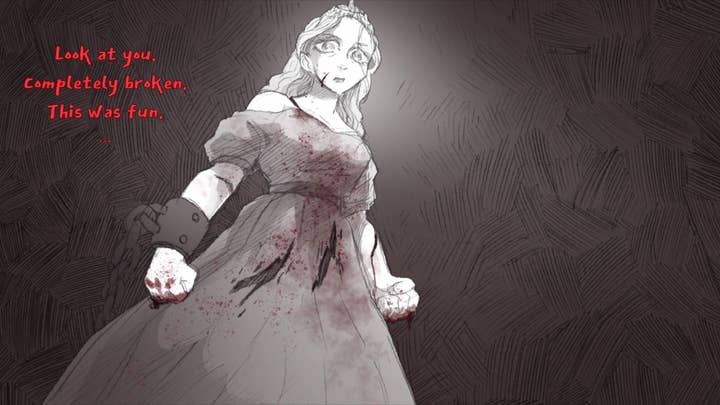Earning wishlists on Steam: A case study
Black Tabby Games' Tony Howard-Arias explains how Slay the Princess earned 25,000 wishlists in two weeks and gives tips to other indies looking to build their audience
(Note: this piece was originally written on August 8th, any data shared is only accurate up to that point in time.)
For those of you who don’t know me, I’m one of the two developers at Black Tabby Games, an indie game studio I run with my wife, Abby Howard. You might know us from our first game, Scarlet Hollow or you might know us from our recently announced second game – and the subject of this article – Slay the Princess.
Scarlet Hollow is an episodic horror visual novel. We started development on the seven-episode game in March of 2020 and launched the first of those chapters for free in late September of the same year, before driving that launch into a successful Kickstarter the following month.
While we initially planned to release the rest of our episodes as DLC for that free-to-play page on Steam, we ultimately decided we were better off pivoting to an Early Access model both for the sake of simplicity as well as to better optimize our visibility during sale events on Steam. And thankfully, that pivot’s paid off – Scarlet Hollow’s been doing quite well for itself!
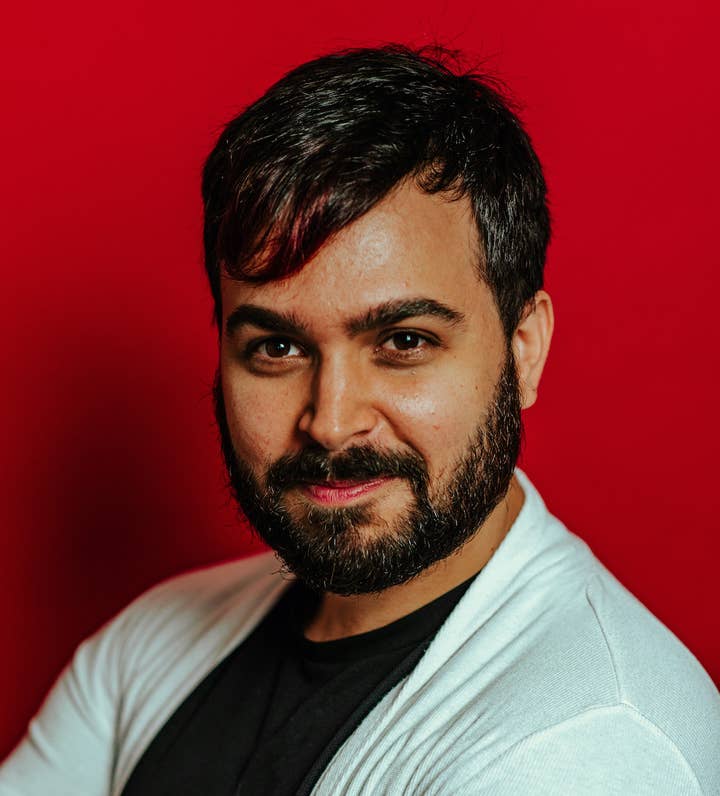
As of the time of this writing, we’ve released the first three episodes of our planned seven, with the fourth slated for this fall. Which undoubtedly begs the question: why are you working on a second game at the same time?
At its core, Slay the Princess was intentionally designed to slip seamlessly into Scarlet Hollow’s workflow, both in terms of effectively utilizing my time while minimizing the demands it would make of Abby’s:
- 1. The premise relies on a single character (at least in terms of physical representation) in a single location, minimizing the breadth and complexity of the art we need without reducing its quality.
- 2. We took the art style Abby developed for Scarlet Hollow and stripped it down to its bare essentials. Every art asset in Slay the Princess is done in pencil instead of inks, which cuts down on time considerably, and the game is monotone, so coloring isn’t a concern either. On top of this, we decided to scale down the size of the paper used for the project: Scarlet Hollow is drawn on 18"x24" paper, while Slay the Princess is drawn of 11"x17" paper.
- 3. The smaller scope of the project means I’m able to write the game very quickly and in parallel to Abby’s first-draft work on Scarlet Hollow. This also had the added effect of making Slay the Princess pretty easy to talk about! While Scarlet Hollow is incredibly complex, the core premise of Slay the Princess is something we can get across in just a single sentence.
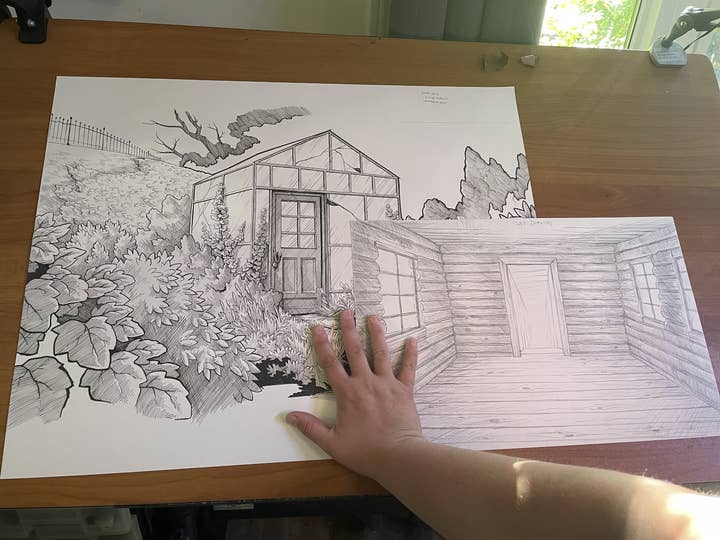
In terms of its impacts on our time commitment, this strategy has so far been a resounding success. I finished my work on the Slay the Princess launch and demo (roughly 1.5 hours of gameplay) in a little under three weeks, and it took Abby an incomprehensibly short six days to put together the 200 illustrations used in the demo!
Pushing ourselves to get the Slay the Princess demo out also had the unintended effect of being a sort of training montage — development on Scarlet Hollow has sped up significantly from the skills and practice we gained through operating on such a tight deadline.
How did a visual novel get 25,000 wishlists in two weeks?
There wasn’t a single magic bullet that led to Slay the Princess getting this level of traction. Rather, that traction is the culmination of a lot of things going right, and it’s coming off the back of years of dedicated audience building.
The overall strategy was pretty simple: we’d announce the page and drop the trailer on the same day, along with a limited access early build of the demo we sent along to a select number of press and influencers.
In terms of timing, we also worked to pick a week that was relatively free of major industry announcements, hoping we’d be able to dominate at least a day’s cycle on social media. This meant we specifically avoided trying to be a part of Summer Game Fest, since we wanted Slay the Princess’ announcement to be the thing people were talking about that day.
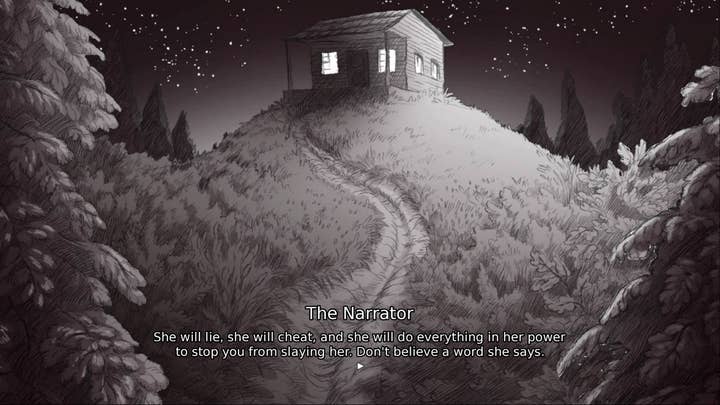
We settled on July 25th for our announcement date, which also happened to give us a week of lead-up before Slay the Princess got to be a part of Tiny Teams, Yogscast's week long festival dedicated to indies. That lead-up, by extension, made room for a week-long exclusivity period where patrons and select influencers could get early access to the demo.
Some of our biggest assets going into the July 25th launch were:
- Our mailing list, which we only tap a couple times a year for big announcements — 8,300 recipients
- The Scarlet Hollow community — in particular, our Discord server (1,500 high-engagement members at the time of the STP announcement)
- Scarlet Hollow’s Steam page (~3,300 followers)
- Abby’s Twitter presence (that good good blue checkmark and just shy of 40,000 followers)
- Relationships we’d already built with a select few influencers through our work with Scarlet Hollow
- A good trailer, and a good demo
- Eye-catching capsule images on Steam

We were lucky enough that YouTubers Gab Smolders and Alpha Beta Gamer were interested in recording full playthroughs before the embargo we set for the trailer reveal. The groundwork we set meant that on the 25th we had:
- Already pre-pitch out to media and streamers (which is also thanks to the PR agency we worked with)
- Two big videos that went live minutes after our announcement
- Sent a high-engagement email blast (8,300 recipients, 60% open rate and 9% click-through rate)
- Primed our Discord and Twitter communities to be ready to amplify our announcement
We were able to get 1,000 wishlists on the first day Scarlet Hollow’s paid Steam page launched, and 2,500 in its first week. Given our track record with that game and the community growth we’d seen in the year and a half since that page launch, we were hoping to double those numbers.
We wound up with just over 2,600 wishlists on the first day, and a little under 14,000 by the end of the first week.
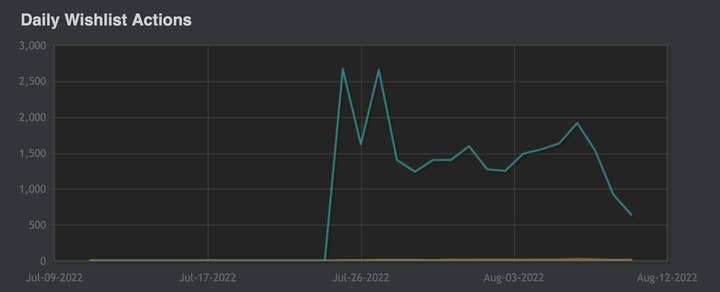
So what went right?
- The trailer
The trailer is probably the most obvious contributor to the announcement’s success, and most of our engagement hinged around it in one way or another. In terms of social media engagement, it wound up doing a little over four times better than Scarlet Hollow’s launch trailer did – I think this is partially attributed to the voice acting really selling it, as well as to the community interest we’ve built up over the course of the past couple of years. On top of the traction the trailer saw on Twitter, it’s gotten another 28,000 views or so on YouTube, and another 50,000 views on TikTok.
On top of providing early access to the demo for a limited number of streamers, we also provided early access to our patrons, and were able to grow our Patreon by about 25% over the course of the week.
This limited access also helped sustain the hype of that initial announcement. It also led to a couple of big YouTubers requesting keys, including ManlyBadassHero, whose playthrough gave the game a second wind, which in turn led to even more coverage from streamers and YouTubers.

- The demo
We released the demo the following Monday and once again outperformed our expectations. As of August 8th, approximately 13,000 people have downloaded that, and about 60% of those folks (8,000 players) have played it. The median player in that group has played for 45 minutes, enough time to uncover at least half of the demo’s endings.
Something that we try to do with all of our games is make efficient use out of our menus in terms of helping our players get plugged into the community. In Scarlet Hollow Episode 1, for instance, we prompt players at the end of the playthrough to wishlist the full game on Steam, and for all of our games, we give players an opportunity to join our Discord server at the end of the playthrough.
Demos for narrative games can be tricky to nail down, but it can be helpful if you approach them with your hooks in mind
With the Slay the Princess demo, we also took the opportunity to let players know about Scarlet Hollow. Like our Discord calls to action, we put this one at the end of the demo, so players ideally see it just when they’re craving more content.
This cross-promotion has wound up being incredibly successful with the Slay the Princess demo – Scarlet Hollow’s sales and wishlist numbers each increased by a factor of 5x over their baseline pre-announcement, with little signs of slowing down at the time of this writing. Similarly, our Discord server has grown by another 50% since the Slay the Princess announcement, jumping from 1,500 to nearly 2,300 members.
Demos for narrative games can be tricky to nail down, but I think it can be helpful if you approach them with your hooks in mind, especially in terms of your ending. You have to assume that your demo is your only chance to get a player interested in your full game, and having a strong cliffhanger and an active community are good ways to capture that interest and leave your players excited for more.
Tony Howard-Arias is one of the co-founders of Black Tabby Games, an award-winning indie studio developing Scarlet Hollow and Slay the Princess. You can follow their work on Twitter @blacktabbygames
More GamesIndustry.biz Academy guides to Selling Games
Our guides to making money from video games cover various aspects of the publishing process, whether you're a young game developer about to start a new project or an industry veteran:
